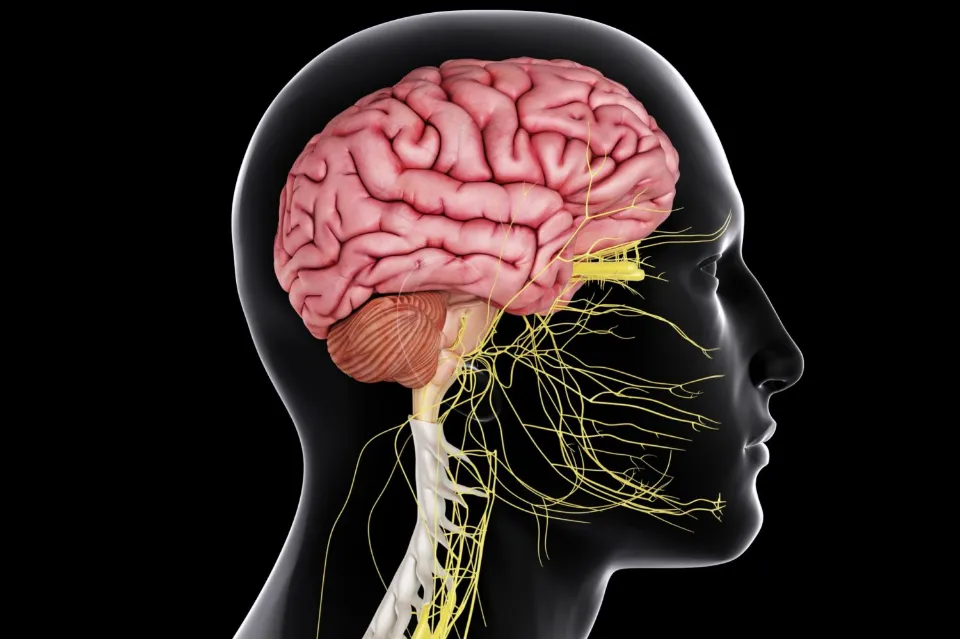The brain and nervous system go through normal aging processes. Atrophy is the loss of neurons and weight in the brain and spinal cord. It’s possible that nerve cells will start transmitting messages more slowly than they once did. Waste products or other chemicals, such as beta amyloid, accumulate in the brain tissue as nerve cells degrade. Plaques and tangles, abnormal brain changes, develop as a result of this. Nerve tissue may also accumulate fatty brown pigments known as lipofuscin.
Your senses may suffer from neurological problems. The reactions or sensations of older people may be diminished or gone altogether. Moving awkwardly, feeling unsafe, and falling more frequently are all possible effects of this.
Are you interested in learning how aging affects the nervous system? Read on!
What Does the Nervous System Do?
Our health and wellbeing are influenced by the nervous system in almost every way. It directs simple processes like waking up, automatic ones like breathing, and complicated ones like thinking, reading, remembering, and experiencing emotions.
The nervous system controls:
- Brain growth and development
- Perception (the mental process of interpreting sensory information)
- Thought and emotions
- Sensations (such as touch or hearing)
- Sleep
- Breathing and heartbeat
- Movement, balance, and coordination
- Hunger, thirst, and digestion
- Healing and rehabilitation
- Learning and memory
- Aging
- Body temperature
- Puberty, reproductive health, and fertility
- Stress and the body’s responses to stress

Both in healthy and diseased states, neuroscientists research these and other nervous system processes. Because it influences so many facets of human health and wellbeing, studying and understanding the nervous system is crucial.
How Does Aging Affect the Nervous System?
The brain, spinal cord, and a network of nerve cells that travel throughout the body make up the nervous system, which is prone to malfunction and disease. Additionally, nervous system cells undergo lifelong changes, just like other cells in the body. They are therefore vulnerable to harm, but they can also be shielded from harmful toxins and free radicals by adopting a healthy lifestyle.
The brain and spinal cord will shrink or lose cells with time. 90-year-old brains were discovered to weigh 11% less than 50-year-old brains. The brain could start to accumulate waste products from cellular metabolism. Nerve cells may become protein-rich. The brain develops an accumulation of pigments like lipofuscin and neuromelanin. Over time, minute modifications to the genetic code may amass, making it more difficult for cells to synthesize the proteins they require and degrade the ones they no longer need. These cellular alterations may result in memory loss and a decline in cognitive health.
Coordination
Changes in the nervous system also have an impact on balance and coordination. Your risk of falling may rise as a result of these changes. Reflexes, strength, and coordination are all interconnected. Coordination can be enhanced and your risk of falling can be reduced by building muscle strength and engaging in activities that test your ability to maintain balance.
Try these movements to improve balance and coordination:
- Stand on one foot.
- Take a line from heel to toe.
- Place your feet on a foam cushion.
- With your eyes closed, advance a few steps.
Work with a spotter to practice your balance and coordination. You can have a friend or family member watch over you to make sure you don’t trip or bump into anything. Verify that there are no additional hazards in the area by looking around you.
Taste and Smell
To activate taste and smell receptors, odorant molecules are dissolved in saliva or mucus. With age, you may produce less saliva, which can affect your sense of taste. Additionally, nasal congestion and drugs that dry out the sinuses can impair your sense of smell. The process of losing taste and smell sensitivity can be accelerated by smoking and exposure to pollution.
Touch
Sensations that are abnormal or diminished can result from decreased blood flow to nerve endings. Small blood vessel deterioration, which leads to nerve deterioration, is frequently brought on by diabetes. Type 2 diabetes can be avoided by losing excess weight and eating a diet that keeps your blood sugar levels within a healthy range. By exercising frequently, you are altering your body composition even if the scale doesn’t change. Increasing muscle mass and decreasing abdominal fat can lower blood sugar levels. Lowering the risk of nerve damage and safeguarding the inner lining of small blood vessels are two benefits of maintaining normal blood sugar levels.
Strength
Muscle cells are full of muscle fibers. Hormones and stress on a muscle can increase the number of myofibrils there, even though the number of muscle fibers in a muscle cell is genetically determined. Myofibril production increases muscle mass and strength. On the other hand, a muscle atrophies and loses myofibrils when it is not used.
Sarcopenia is the age-related loss of muscle mass and strength. Muscle is lost at a rate of 0.5% to 1.0% per year after age 70. Up until the age of 70, strength declines by 10% to 15% per decade; thereafter, it declines by 20% to 40% per decade.
Movement
Muscle movement is controlled by areas in the frontal cortex of the brain. Control over the left side of the body is exerted by the right motor cortex, and the right side by the left motor cortex.
Growth hormones and androgens such as testosterone are hormones that stimulate muscle growth and bone density. Regrettably, hormonal aging also takes place, leading to modifications in body composition like decreased strength, bone density, and muscle mass. Some people use supplements that boost growth hormone release from the pituitary gland in the brain, like sermorelin, to slow the effects of aging.

Attention
Information processing may be slowed down by decreased brain processing power. Older adults might discover that it is more difficult to focus attention on multiple tasks at once as a result. Because brain tissue is plastic, just like muscle tissue, it’s possible to improve your ability to pay attention. By exercising aerobically, you can also improve blood flow to the brain. Improved metabolic functions in brain cells are a result of increased blood flow. How this occurs is not known.
One task that frequently requires attention switching is driving. Strengthening your ability to focus your attention on multiple tasks at once or on unfamiliar tasks may help you retain your driving skills much longer in life.
Memory
Aging can lead to changes in working memory. But it’s unclear how and why these changes take place. Brain scans show that older adults may use different parts of their brains for working memory than younger adults.
The capacity to recall information that has been temporarily stored in the brain is known as long-term memory. Memories from your own experiences are called episodic memories. They take place in a location and at a specific time. With aging, people may have trouble retrieving or encoding new episodic memories in the brain.
Tips to Keep Your Nervous System Healthy
Exercise regularly-Exercise has many well-known advantages, and regular physical activity is also good for the brain. Numerous studies have shown that people who are physically active have lower rates of cognitive decline and Alzheimer’s disease.
Remain socially involved-Social interaction helps ward off depression and stress, which can contribute to memory loss. Look for opportunities to connect with loved ones, friends and others, especially if you live alone. Being socially active may have the opposite effect and improve the health of your brain since research links solitary confinement to brain atrophy.
Get plenty of sleep-Your ability to think clearly depends on how well you sleep. According to some theories, sleep strengthens memories and helps your brain clear out abnormal proteins, which improves your overall memory and brain health.
Stay mentally active-Like a muscle, your brain needs to be exercised regularly to prevent atrophy. There are many things that you can do to keep your brain in shape, such as doing crossword puzzles or Sudoku, reading, playing cards or putting together a jigsaw puzzle. Think of it as brain-training variety. To improve effectiveness, include a variety of activities.
Conclusion
Aging is a natural process that causes our thoughts, memory, and thinking to slow down. Not everyone experiences these changes the same way. The nerve and brain tissue of some individuals has undergone numerous alterations. Others hardly alter at all. These alterations aren’t always connected to how they affect your ability to think. Try the aforementioned suggestions if you’re feeling anxious.



